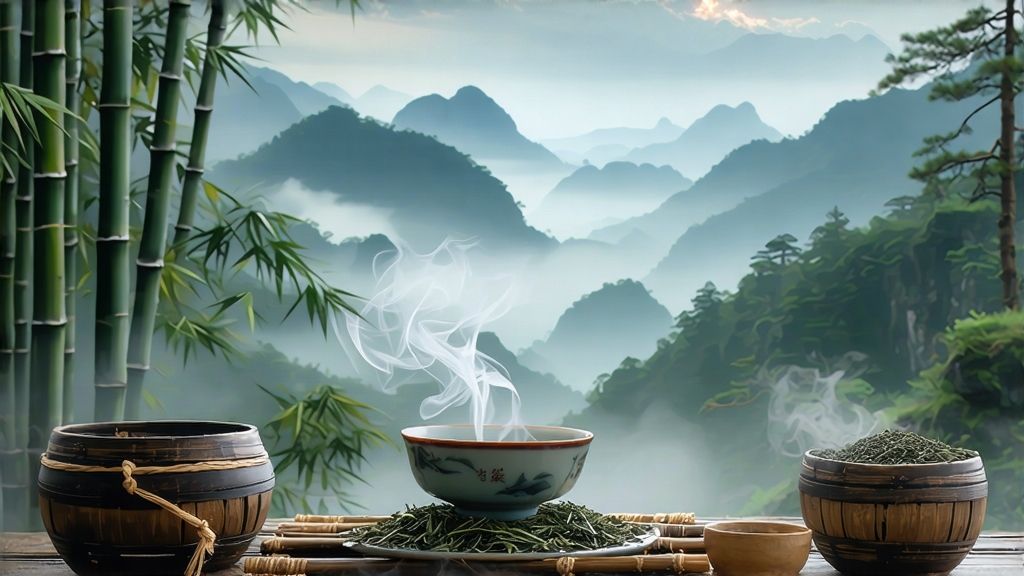
Long before English porcelain teacups clinked in London drawing rooms, the first black tea ever created was quietly born in the rugged Wuyi Mountains of northern Fujian. Locals call it Zheng Shan Xiao Zhong—“small leaf from the original mountain”—but the outside world knows it as Lapsang Souchong, the primordial black tea whose accidental birth in the mid-seventeenth century launched a global obsession. This is the story of how a single pine-smoked leaf rewrote trade routes, inspired entire industries, and still rewards the patient drinker with a cup that tastes of mist, resin, and dried longan.
-
Terroir: why Wuyi matters
The National Nature Reserve that cradles Tongmu Village sits inside a granite canyon where the Fujianese subtropical monsoon collides with cool air sliding off Jiangxi’s high plateau. Daytime heat hovers around 28 °C, nights drop to 14 °C, and humidity rarely dips below 85 %. The result is a perpetual cloud blanket that forces the tea bush (here the indigenous Xiao Ye Zhong cultivar) to grow slowly, thickening cell walls and concentrating aromatic volatiles. Soils are lateritic, rich in iron and quartz, and drain so quickly that roots plunge two metres in search of water, mining minerals that translate into a natural sweetness rare in black tea. Within this 600 m–1200 m band, only 52 square kilometres are authorised to produce true Zheng Shan Xiao Zhong; step outside the boundary and the same cultivar yields a dull, flat liquor that refuses to hold smoke. -
Two families, two styles
Tongmu farmers still divide their harvest into two philosophical camps. Traditional Lapsang Souchong (you xun) is withered over towering pinewood fires, smoked, and then re-smoked, emerging almost black and heavily tarred—an assertive tea that scented the docks of Canton in 1660. Contemporary “unsmoked” Xiao Zhong (wu xun) appeared only in 2005, when a Beijing merchant begged for a subtler leaf that could pass EU pesticide limits. Craftsmen skipped the final smoking stage, allowing the honeyed, stone-fruit character of the Wuyi spring to speak first, with only a whisper of resin in the finish. Both styles share the same plucking standard—one tender bud plus two leaves, harvested before Qingming when the dew still smells of wild azalea—but diverge at the moment smoke meets leaf. -
The craft: sixteen hours of controlled fire
Smoking begins at dusk. Fresh leaves, having lost 60 % moisture on bamboo racks above gentle charcoal embers, are transferred to the lowest level of a three-tiered brick oven. Below them, forty-year-old Masson pine roots, stripped of bark and soaked overnight, smoulder at 80 °C, never flame. The tea master, barefoot to feel heat through the slats, tosses the leaf every three minutes for four hours, allowing resinous vapours to penetrate stomata. At midnight the leaf is rolled under canvas until cell breakage reaches 85 %—the threshold at which polyphenols meet enzymes to create theaflavins that give coppery colour. Oxidation follows in cedar-lined boxes kept at 26 °C and 90 % humidity; four hours later the leaf smells of ripe peach and pine sap. A final 90-second blast of 120 °C heat halts oxidation, sets the smoke, and reduces moisture to 3 %. The entire process must finish before the canyon sun burns off the morning mist; otherwise the leaf absorbs unwanted top notes of wild garlic that grow beneath the tea hedges. -
Leaf grades and market names
Within the authorised zone, only three grades may legally bear “Zheng Shan Xiao Zhong” on the tin. Jipin (supreme) consists of buds alone, picked within a five-day window; it steeps into a liquor the colour of sherry with a lingering note of lychee and cigar box. Teji (special) mixes bud and first leaf, yielding a brighter cup balanced between malt and resin. Yiji (first) uses the standard two-leaf pluck, delivers the classic campfire punch, and is the grade most often blended into Russian Caravan or Earl Grey bases. Anything else